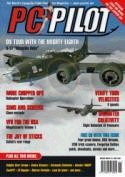PC PILOT MAGAZINE REVIEW:
"Life is hard for the pilot who wants to use an aircraft seriously but lacks an instrument rating - a fact that's particularly true in the British Isles, where poor weather prevails and the nation's choicest airspace is open only to those with an instrument rating. The catch is that becoming instrument-rated is a costly exercise, one that in the UK can easily lighten your bank balance by £15,000. Any tool, therefore, that helps an aspiring instrument pilot make the best use of ground preparation time as a way of controlling costs in the air has to be worth considering.
In the US, approved PC flight simulators can be used under the watchful eye of a certified instructor to log the initial hours of a formal instrument training programme, and budding US Navy aviators have been issued with a copy of Flight Simulator ever since this arm of the military concluded that the software improves learning. Closer to home, PC Pilot has reported how the Defence Helicopter Flying School at RAF Shawbury uses a PC-based helicopter instrument trainer.
CockPIT is an instrument flight simulator bundled with a comprehensive handbook and is aimed squarely at the serious student of fixed-wing instrument flight. Complementing its ability to run on a very modest computer, CockPIT's biggest attraction is its series of practical exercises, which grade you as you fly and follow a logical instruction syllabus.
The Pilot Training Manual, at 140 pages, is the largest section of the CockPIT handbook and follows a 40-page introduction that details how to install, register, configure and use the software; as well as the simulator and programmed exercises it also provides a navigation log and a weight and balance calculator to help with pre-flight preparation; there's also a useful tool that handles conversions ranging from pressure and power to moment of force.
The manual is an excellent summary of the essential theory of instrument flight and is particularly handy because it manages to combine a comprehensive approach with compactness. It gathers information into a single reference volume and lets you in on the pragmatic tips instructors use to help students handle the mental gymnastics that are a feature of instrument flight. The material is arranged in the logical sequence typical of a real-world training syllabus, starting with the basics of attitude instrument flying and closing with the complex subject of holding patterns. The only real criticisms that can be levelled at the handbook are an absence of colour and a paucity of illustrations.
The CockPIT simulator is initially disconcerting if you're an ardent fan of current flight sims or a real-world pilot; CockPIT's simulated aircraft is engineered to be particularly stable and to stay where it's put. The aircraft - it performs like a Cessna 172SP - is impossible to stall, automatically pitches up if you overspeed and limits your bank angle to 45 degrees.
CockPIT's authors have dubbed this stability feature 'Automatic Longitudinal Trimming', or ALT for short, stressing that it allows pilots to focus entirely on learning instrument and navigation procedures rather than struggling to control the aircraft itself. Pilots just starting instrument training and discovering the mental workload that's involved will find ALT a real bonus.
The ALT system does have the benefit of making the CockPIT simulator truly flyable using a keyboard, something that isn't a rewarding experience with most sims. If you travel with a laptop so that you can snatch quality training time, CockPIT has its attractions.
CockPIT's instrument panel and maps are basic compared with those found in the current crop of civil sims, but are consistent with the software's primary aim of teaching core instrument flying skills and with the style of other simulators used for serious aviation training. CockPIT has a fictitious practice area with three VOR (Very-high frequency Omni-directional Range), three NDB (Non-Directional Beacon) navigation aids and a single ILS (Instrument Landing System) that's used for flying the programmed exercises. If you want to fly freely in a part of the world you're familiar with, then you'll need to use the area editor to create your own locale; the task is straightforward, if tedious.
Each custom locale can have up to 15 VOR, 15 NDB and 15 ILS systems, but you'll need to manually enter latitude, longitude, magnetic variation and other essential information for each, culling it from aeronautical charts. Compact data files define each custom locale, and the starting location and weather conditions that you want; these are saved in accessible Windows folders so sharing data with other users is possible. Valuably, starting positions can be defined relative to an instrument approach's locator outer marker, not just to a VOR, NDB or ILS transmitter; if you're new to the art of flying instrument approaches you can give yourself a head start by placing your aircraft precisely at the final approach fix and aligned with the final approach or localiser course.
CockPIT won't appeal to everyone. But if you're serious about starting a structured instrument training programme, CockPIT is worth examining particularly if you have only a modest PC. The printed material provides an excellent summary of the theory of instrument flying, punctuated with valuable suggestions and hints. It also links effectively with the simulator's programmed exercises that will test whether you really can apply the instrument flying theory you've learned.
lain Dawson.
At a glance: An ideal tool for serious students
of fixed-wing instrument flying.
System Requirements: 75MHz processor, Windows 95 or later, 32Mb RAM, 4Mb
disk space.
Recommended: If you're running any other sim successfully, you're unlikely to have trouble with CockPIT!"
PC Pilot Issue 25, November/December 2003.
|
REVIEW
SCORE "An ideal tool for serious students of fixed-wing instrument flying." |
©2003 - 2015 CockpitWeb.com. All rights reserved.
